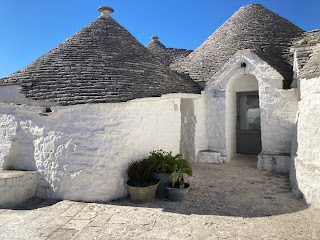Ancient Abodes in Apulia
For five days in February, I participated in a Road Scholar tour of Puglia, as we spell the Italian region of Apulia in English. Apulia is long and narrow, the heel of Italy’s boot, the land between the Ionian and Adriatic Seas. We explored only the southern portions of the region and dipped into neighboring Basilicata one day. There is much to see and enjoy in Apulia—beaches, low mountains, beautiful cities, and historic sites. I have described these is other posts.
Another ancient people settled in the mountain caves in what
is now the city of Matera. These rock
cities, or sassi, are the only continuously inhabited dwellings dating back for
at least nine thousand years.
“The facades of the caves were like a row of white houses;
the holes of the doorways stared at me like black eyes. . . .As I went by I
could see into the caves, whose only light came in through the front
doors. In these dark holes with walls
cut out of the earth I saw a few pieces of miserable furniture and some ragged
clothes hanging up to dry. Most families
have just one cave to live in and here they sleep all together: men, women,
children, and animals. This is how
twenty thousand people live. . . . The women, when they saw me look in the
doors, asked me to come in, and in the dark, smelly caves where they lived I
saw children lying on the floor under torn blankets, with their teeth
chattering from fever. The thin women,
with dirty, undernourished babies hanging at their flaccid breasts, spoke to me
mildly and with despair. I felt as if I
were in a city stricken by the plague.”. . .
It was this description of the
indescribable misery, poverty, and illness of these residents that led the
Italian government in the 1950s to move the occupants out of the caves and to
begin to clean up the mess. Now the
Sassi are a major tourist destination with bed-and-breakfasts, restaurants, and
shops occupying reclaimed and renovated cave.
There are more than a thousand of these houses—trulli—standing in the town of Alberobello alone. Again, they have been remodeled to house a variety of businesses and are available for tourists as bed and breakfast rentals.
What was old becomes new again.











